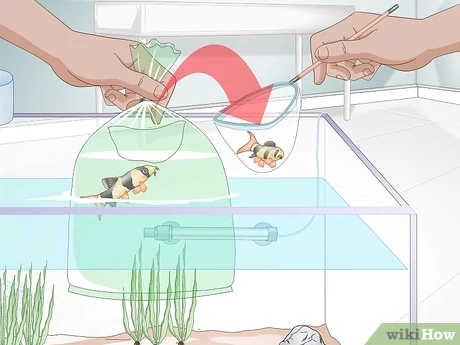Acclimating fish to a new environment is a crucial step in ensuring their health and well-being. The process of acclimation allows fish to gradually adjust to changes in water parameters, such as temperature, pH, and water chemistry, reducing the stress associated with being introduced to a new habitat. The duration of the acclimation process can vary depending on factors such as the type of fish, the size of the tank, and the difference between the water parameters of the original and new environments. In this comprehensive guide, we will explore the importance of acclimation, the factors that influence the duration of the process, and the steps to properly acclimate fish to their new home.
The Importance of Acclimation
Acclimation is crucial for the health and well-being of fish. Sudden changes in water parameters can cause significant stress to fish, weakening their immune system and making them more susceptible to disease. By gradually introducing fish to their new environment, acclimation helps reduce the risk of shock and stress, allowing them to adapt more smoothly to their new surroundings.
Potential Consequences of Improper Acclimation
- Stress: Abrupt changes in water parameters can cause significant stress to fish, leading to a weakened immune system and increased susceptibility to disease.
- Shock: Sudden changes in water parameters can cause fish to go into shock, which can be fatal if not addressed promptly.
- Aggression: Improperly acclimated fish may be more aggressive towards other tank inhabitants, leading to fighting and potential injuries.
- Disease: Stressed fish are more prone to developing diseases, which can spread to other tank inhabitants if not treated promptly.
Factors Influencing Acclimation Duration
The duration of the acclimation process can vary depending on several factors, including:
- Water Parameters: The difference between the water parameters of the original and new environments can affect the duration of acclimation. The greater the difference, the longer the acclimation process may take.
- Fish Species: Some fish species are more sensitive to changes in water parameters than others. Delicate species, such as discus and angelfish, may require a longer acclimation period compared to hardier species like guppies and tetras.
- Fish Size: Larger fish may require a longer acclimation period compared to smaller fish, as they have a higher metabolic rate and are more sensitive to changes in water parameters.
- Shipping Stress: Fish that have recently been shipped or transported may require a longer acclimation period to recover from the stress of travel and adjust to their new environment.
Acclimation Methods
There are several methods for acclimating fish to their new environment, each with its own advantages and disadvantages. The most common methods are:
- Floating Method: This method involves floating the fish in their original water inside the bag or container for a specified period, typically 15-30 minutes, to allow the water temperature to equalize. After the initial float, small amounts of water from the new tank are added to the bag every 5-10 minutes until the bag is full. The fish are then netted and released into the new tank.
- Drip Method: This method involves setting up a slow drip system using airline tubing and a container filled with water from the new tank. The fish are placed in the container, and the drip system is set to add a few drops of water per second. This allows for a gradual change in water parameters over an extended period, typically 2-4 hours.
- Bag Method: This method is similar to the floating method but involves adding water to the bag in larger increments. The fish are floated in their original water for 15-30 minutes, and then the bag is opened, and water from the new tank is added in 25% increments every 15 minutes until the bag is full. The fish are then netted and released into the new tank.
Acclimation Duration Guidelines
The duration of the acclimation process can vary depending on the method used and the specific circumstances of the fish being acclimated. Here are some general guidelines for acclimation duration:
| Method | Duration |
|---|---|
| Floating Method | 15-30 minutes for temperature equalization, followed by 5-10 minute increments of adding new tank water until the bag is full. |
| Drip Method | 2-4 hours, depending on the size of the container and the drip rate. |
| Bag Method | 15-30 minutes for temperature equalization, followed by 25% increments of new tank water every 15 minutes until the bag is full. |
It’s important to note that these are general guidelines, and the actual acclimation duration may need to be adjusted based on the specific circumstances of the fish being acclimated.
Factors Affecting Acclimation Duration
- Water Parameter Differences: The greater the difference in water parameters between the original and new environments, the longer the acclimation process may need to be.
- Fish Species: Some fish species are more sensitive to changes in water parameters than others. Delicate species may require a longer acclimation period compared to hardier species.
- Fish Size: Larger fish may require a longer acclimation period compared to smaller fish, as they have a higher metabolic rate and are more sensitive to changes in water parameters.
- Shipping Stress: Fish that have recently been shipped or transported may require a longer acclimation period to recover from the stress of travel and adjust to their new environment.
Acclimation Tips
- Observe the Fish: Monitor the fish closely during the acclimation process for signs of stress or distress, such as rapid breathing, erratic swimming, or loss of appetite.
- Maintain Water Quality: Ensure that the water in the bag or container remains clean and free of waste buildup during the acclimation process.
- Avoid Sudden Changes: Gradually introduce the fish to their new environment by making small changes to water parameters over time.
- Use Dechlorinator: If the new tank water contains chlorine or other chemicals, use a dechlorinator to remove them before adding the fish.
- Provide Hiding Spots: Ensure that the new tank has plenty of hiding spots, such as plants or decorations, to help the fish feel secure and reduce stress.
Acclimating Specific Fish Species
Saltwater Fish
Saltwater fish are generally more sensitive to changes in water parameters than freshwater fish and may require a longer acclimation period. The drip method is often recommended for saltwater fish, as it allows for a gradual change in water parameters over an extended period.
Freshwater Fish
Freshwater fish are generally less sensitive to changes in water parameters than saltwater fish and may require a shorter acclimation period. The floating method or the bag method is often recommended for freshwater fish, as they are less sensitive to changes in water parameters.
Delicate Fish Species
Delicate fish species, such as discus and angelfish, are particularly sensitive to changes in water parameters and may require a longer acclimation period. The drip method is often recommended for delicate fish species, as it allows for a gradual change in water parameters over an extended period.
Conclusion
Acclimating fish to their new environment is a crucial step in ensuring their health and well-being. By gradually introducing fish to their new habitat, acclimation helps reduce the stress associated with changes in water parameters and allows fish to adapt more smoothly to their new surroundings. The duration of the acclimation process can vary depending on factors such as the type of fish, the size of the tank, and the difference between the water parameters of the original and new environments. By following the guidelines and tips outlined in this article, aquarium hobbyists can ensure that their fish are properly acclimated and thrive in their new environment.



